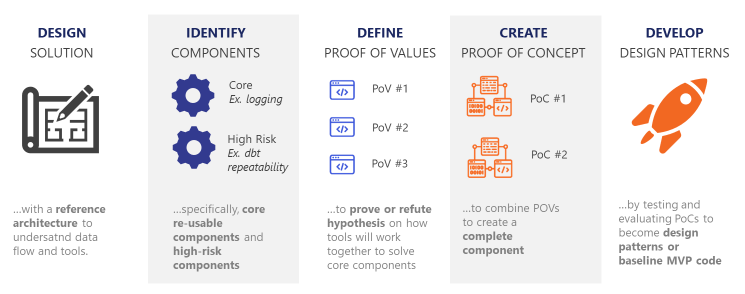6-minute read
Snapshot
When a telecom enterprise’s financial team needed to accelerate the migration of their legacy accounting system to the cloud, they partnered with Logic20/20. Our team of senior architects, developers, and accounting subject-matter experts (SMEs) built a solid foundation for a complex system migration. Incorporating best practices in change management and Agile, we worked with their in-house team and their offshore junior developers to ensure that the migration was completed securely and efficiently while minimizing technical debt. The results were a $7 million annual reduction in total cost of ownership and an 80 percent reduction in deployment process time, which our client’s leadership described as “nothing short of exceptional.”
We brought our expertise and experience in
- Legacy database migration to cloud architecture
- Subledger accounting
- Revenue recognition
- Azure Data Platform (including Azure Data Factory)
- Snowflake
- dbt
- DataOps (including CI/CD)
Connecting Americans from coast to coast
Known for their strong customer base, large network size, and competitive pricing, our client has served the telecommunications needs of Americans across the nation for decades. Today their customers number more than 115 million, and their network covers 98 percent of the U.S. population. The enterprise is widely respected as an industry leader in customer service and in the development of new wireless technologies. They had also recently completed a series of mergers and acquisitions and were addressing the challenges of integrating new organizations into the enterprise.Accelerating a legacy accounting system migration
Our client’s financial team was planning a legacy system migration to the cloud, driven by two key factors: a company-wide initiative to migrate from an on-premise database management system (DBMS) (Teradata) to a cloud-based solution (Snowflake), and the fact that their existing accounting system only worked with Teradata. They made the decision to leapfrog the enterprise initiative and initiate their migration ahead of schedule.
When they reached out to Logic20/20, we began by discussing the business goals and technology-first principles that were driving the migration. Together we determined which factors were and were not going to change, and we worked with them to come up with a list of capabilities and architecture foundations that were non-negotiable. They were very clear about their top priorities for the new system: portability and avoiding vendor lock-in.
Our client had also accumulated a considerable amount of technical debt related to their previous platform. Numerous developers had created code over the years, heavily utilizing design patterns optimized for on-premise Teradata, which would be inefficient and expensive for a distributed cloud computing database like Snowflake. The legacy code was slow and difficult to interpret and troubleshoot. The new ELT design patterns needed to overhaul the code to remove these issues.
Navigating a complex journey to the cloud
Logic20/20 combined technical expertise, subject-matter knowledge, and proficiency in change management to support the achievement of our client’s goals. We partnered with their architects and lead developers to co-create the solution, designing several data platform architecture and solution design options and meeting with them weekly to review the pros and cons of each.
From there, we came up with a short list of technologies and identified the key capabilities the client needed from each component. We identified the core functionality that would establish the proof of value (POV) for the new architecture, which enabled us to develop proofs of concept (POCs) that built confidence in our design patterns. Our team then worked with the client to review each option, meeting with them weekly to demo the POCs and POVs, and together we came to an agreement on the best path forward.

One advantage our team brought to the table was a depth of subject-matter knowledge in accounting, particularly in working with upstream ERP systems, revenue recognition, and subledger management. Our accounting SMEs enabled us to understand at a detailed level how the client operated, the capabilities they needed from the solution, and how it would need to connect to upstream and downstream systems. One consultant in particular had extensive accounting experience with this client and other telecom enterprises, so he was able to ask the right questions for helping the client consider the long-term impact of the project.
Addressing the challenge of the modern data stack
We had evaluated numerous technologies for the client’s data stack and had excluded dbt for a few core reasons. Six weeks later, dbt released a new version that addressed those issues and thus made their product the best choice. However, we were six weeks along in developing the other solution, which relied heavily on JavaScript stored procedures in Snowflake. Together we assessed the architectural, business, and timeline impacts of this change to determine whether we should switch technologies. The client confirmed their architecture-first principles of a solution that would be more future-proof and decrease long-term maintenance costs. The newly implemented solution simplified maintenance with automated documentation and provided greater technology portability, as it was a separate ELT tool rather than a functionality embedded in Snowflake. So if, for example, the client had to transition from Snowflake to Databricks in the future, it would be less painful.dollar annual reduction in total cost of ownership
%
reduction in deployment process time
Helping the team ramp up
When the platform design was finalized, we refined our ELT design patterns and took a hands-on approach to training the offshore developers using the code templates. Our design incorporated checks during each step of data processing to ensure that no data was lost, manipulated, or changed during the process—creating critical trust in the financial systems. This included other platform best practices in DataOps such as source control and CI/CD pipelines. Our team remained in place for several weeks to continue training and coaching the junior team, answer questions, and ensure a smooth migration process.Arriving at the finish line
Our client was delighted with our process that enabled them to combine strategic consulting with optimized use of more junior resources. The solution helped them achieve their goal of avoiding vendor lock-in to prevent the need for an expensive application migration if they need to move off their database in the future, and they now have the freedom to evolve their technology stack with the most fitting solutions as their business changes. Finally, we helped the client become comfortable with the new cloud technology and achieve their goal of educating and up-leveling their team while optimizing their costs for long-term operations and maintenance.
The accounting team completed its full migration from Teradata to the AI-ready Snowflake data platform of the future that Logic20/20 built. Their leadership team used the phrase “nothing short of exceptional” in describing the results, which included:
- Substantial savings, with an estimated annual reduction of $7 million (OPEX) in total cost of ownership (TCO)
- A remarkable 80% reduction in deployment process time, enhancing overall operational agility

Put your data to work for you
- Data strategy
- Data science
- Data engineering
- Visual analytics
Want to start a project like this?


